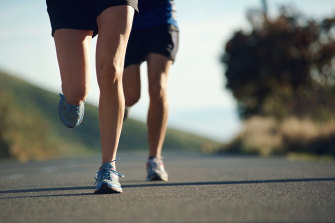If knee replacement surgery already seems like a rite of passage at a certain age, just wait until 2030. By then the current numbers – around 65,000 a year – are predicted to jump by 276 per cent thanks to increasing weight gain and an ageing population.

First twinges of knee pain should be a call to action – not just to lose weight or prevent gaining more – but to get levels of blood pressure and cholesterol checked too.Credit:iStock
Yet knee pain from osteoarthritis needn’t go hand in hand with ageing – or running. Research has shed new light on its causes, and we can forget blaming it all on “wear and tear”. The kilo creep is a major culprit, not only because it burdens the knee joint with extra weight but also because too much fat around the waist produces inflammatory chemicals that damage knee cartilage, explains Professor Flavia Cicuttini, head of Rheumatology at Melbourne’s Alfred Hospital and of Monash University’s Musculoskeletal Unit.
“We hear so much about the need to lose weight but the emphasis should be on preventing weight from creeping on in the first place. On average, Australians gain around half a kilo a year up until the age of 55 – yet it’s so much easier to avoid gaining 500g a year than it is to lose five kilos or more 10 years later.”
Besides, weight loss doesn’t do as much as you’d think to improve knee pain once osteoarthritis has set in – clinical trials have shown that a five to 10 per cent weight loss has only a modest effect, about the same as taking Panadol, she adds.
“The damage has already been done. But we should capitalise on the fact that avoiding or slowing further weight gain will prevent the early niggling joint pains we often experience in our 30s and 40s from becoming worse.
Loading
“Those first twinges of knee pain should be a call to action – not just to lose weight or prevent gaining more – but to get levels of blood pressure and cholesterol checked too,” she says. “Knee osteoarthritis and artery problems are interlinked – when you take an MRI of a knee with osteoarthritis you often see narrowing of the blood vessels as well as joint damage – it’s likely that these narrowed blood vessels are not delivering enough nutrients to the joint.”
Which is where recreational runners may be doing their knees a favour.
“People worry that running will wear out the knee joint but it can improve joint health by providing nutrition to the articulate cartilage of the knee by keeping the joint moving,” says Professor Ilana Ackerman, Deputy Director of the Monash-Cabrini Department of Musculoskeletal Health and Clinical Epidemiology at Monash University. “Recreational runners have lower rates of knee osteoarthritis compared to people running at an elite or competitive level, and compared to people living a more sedentary lifestyle.
Stay connected with us on social media platform for instant update click here to join our Twitter, & Facebook
We are now on Telegram. Click here to join our channel (@TechiUpdate) and stay updated with the latest Technology headlines.
For all the latest Life Style News Click Here
For the latest news and updates, follow us on Google News.
